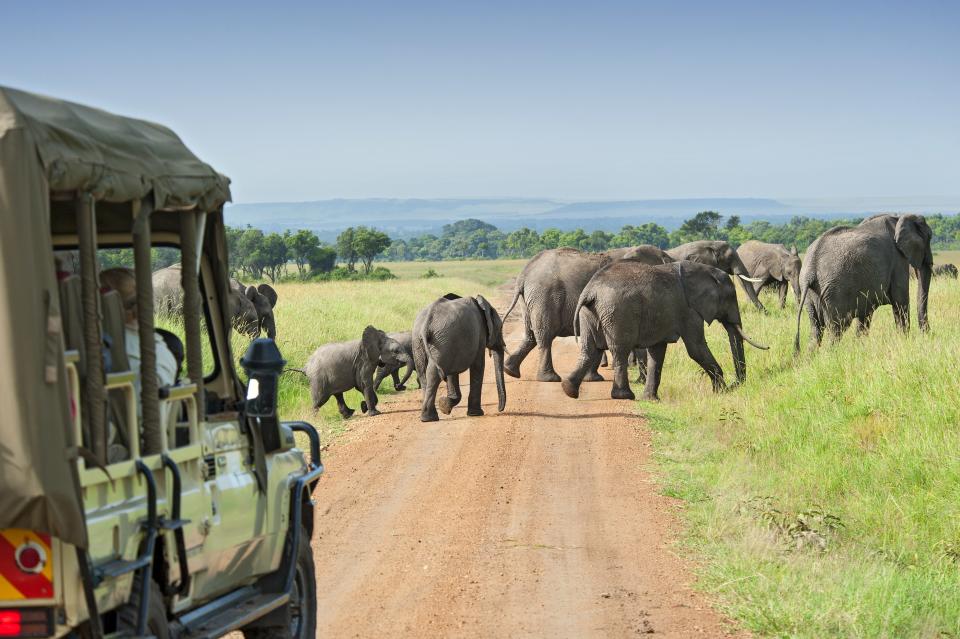African Safari 101: What to Pack (And What to Leave Behind)
Packing for an African safari can be tricky business—especially considering that the small charter planes taking you to your destination have strict luggage weight limits—often under 40 pounds. And while your tour operator will most likely send you guidelines after you book, we also have tips from our safari experts. From necessary tech and gear to packing for all weather conditions (yes, it can get cold), keep scrolling to read their about their safari essentials.
Sarah Taylor, Special Projects Coordinator at Africa Adventure Company
Bring a guidebook. It's helpful to have a reference book, like Mark Nolting’s African Safari Field Guide. "This handy resource is ideal for first-time and repeat safari-goers, as it gives a comprehensive list of the different species frequently seen on safari," says Taylor. "It also includes a journal section for jotting down memories, recipes, and contact information."
Most camps provide laundry services, so pack just three to four outfits. "Stick with 'quick dry,' athletic/sports materials: they keep you cool and are made for traveling," she says. "Think fishing shirts and hiking pants, and check out brands like REI, Mountain Hardware, Marmot, and Columbia."
"For women, pack a versatile scarf—one that can be used as a shoulder wrap/shawl, wrapped as a hood for cold mornings and nights, or even used as a blanket on flights. And we suggest comfortable, waterproof walking shoes (avoid the ones with materials like leather, or a very porous sole that will hold water)."
If you're prone to getting carsick, pack a motion sickness relief band. "They're ideal for the charter flights since they don’t cause drowsiness," Taylor says.
Bring business cards."You will have the opportunity to chat with lots of wonderful people along the way who share a similar spirit of adventure, so stay in touch with them," she says.
Julian Harrison, CEO and Owner of Premier Tours
You'll want to blend in—but not too much. "Camouflage clothing is not recommended for travel in southern African countries. Camouflage or military-inspired clothing is prohibited when traveling in Zimbabwe," says Harrison.
Make sure you (and your gear) are protected. Pack tissues/Wet Ones; insect repellent; a basic medical kit with aspirin, band aids, Imodium, antiseptic/anti-histamine cream; camera equipment; chargers/adaptors; malaria tablets; binoculars (8X40/8X42 is the recommended general-purpose binocular specification for both birding and mammal viewing); a waterproof/dustproof bag/cover for your camera; good quality sunglasses; glasses, as wearing contacts might make you susceptible to dust irritation; moisturizer; and sunblock.
Nina Wennersten, Co-Owner of Hippo Creek Safaris
Stick to duffel bags—and avoid bright colors. Wennersten recommends ditching wheels—which can add about eight to 12 pounds of weight—in favor of a lightweight duffel. As for clothing, neutral colors are the best way to go. "Khaki and tan are the preferred colors when going on a game walk, but most of the time in East Africa, you are in a safari vehicle and can wear jeans/shorts with T-shirts in almost all colors," Wennersten says. " However, avoid shirts that are purple, red or royal blue—bright colors seem to make the animals shy away. Biting insects like tse-tse flies are attracted to striped patterns of royal blue/black, so don't wear this combination if possible."
Bring a surge protector. "Besides your usual electronics, a power strip from home is essential so you can plug that into the camp or lodge outlet and then charge all of your items at one time," Wennersten says. "Most camps have one outlet or plug that will accept your American 110 volt plug."
Make sure you have your documents in order. Wennersten says you'll need to present an "International Certificate of Vaccination (yellow fever inoculation)" for travel to Rwanda and Uganda, as well as Tanzania/Zanzibar if you're arriving from Kenya, or were in Kenya on another leg of the trip. If you're traveling to Kenya, you need a physical copy of your eVisa so you can present it at immigration.
What to Wear on Safari
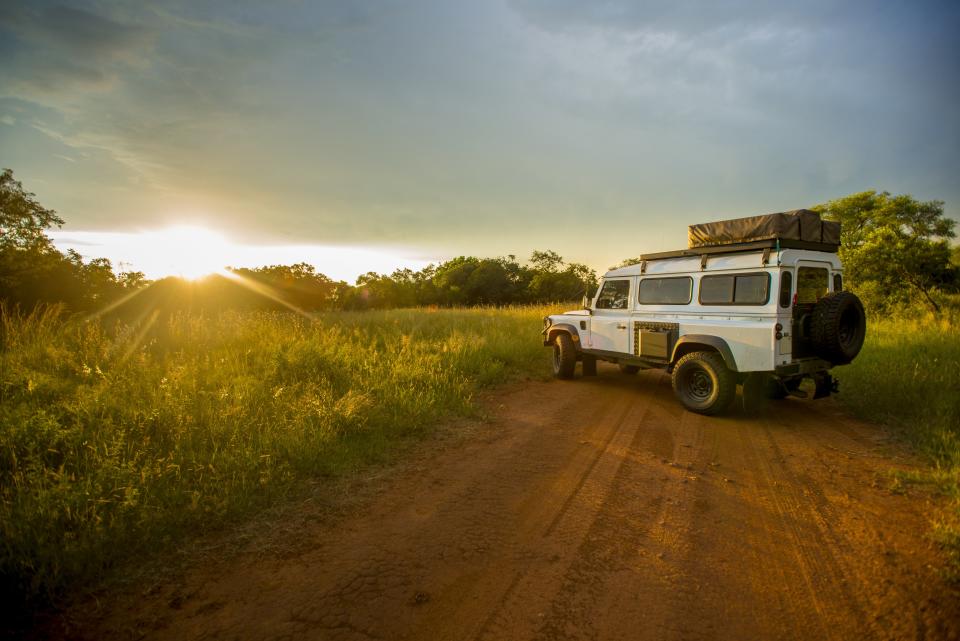
Into the sunset
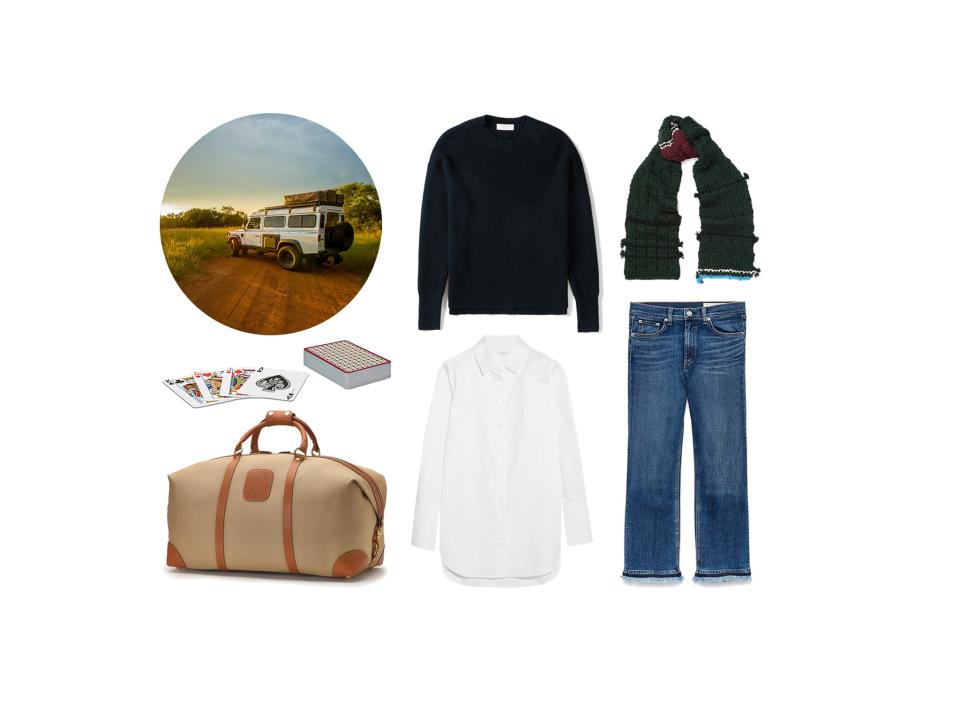
Getting There
Most safari camps are only accessible by small propeller planes, which don’t allow hard-sided luggage. Pack everything in soft duffels that can be easily tossed into the back of the plane or the back of a Land Rover (weight limits are strict, too, so make sure you check with the outfitter before you go). Our advice: have your camera handy for the views, and bring along some low-tech entertainment as well.
Hermès Play Tie Poker playing cards ($115, hermes.com); Ghurka Cavalier III No. 98 Twill Duffel Bag ($1,595, ghurka.com); Everlane The Waffle Knit Cashmere Square Crew ($155, everlane.com); Equipment Arlette shirt ($220, net-a-porter.com); Prada scarf ($690, net-a-porter.com); Rag & Bone/Jean Hana Croyden ($250, aritzia.com).
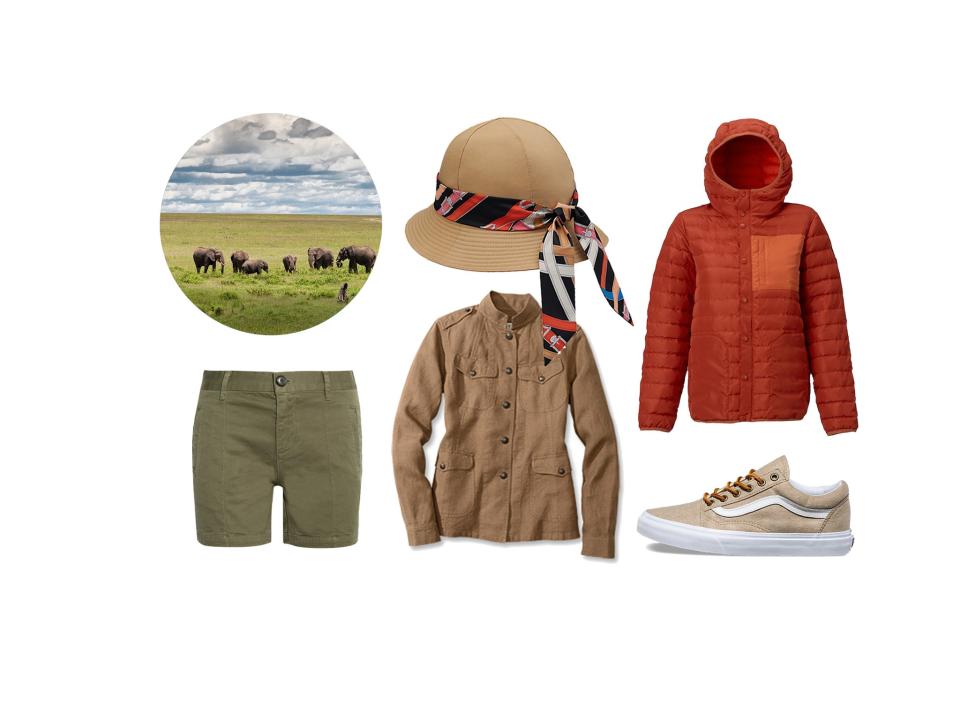
On a Game Drive
Specialists disagree on the details, but you’re generally advised to avoid red and white clothing (as well as anything day-glo) while on game drives because it can attract insects or make you more visible to certain animals. Instead, go for clothing in shades of khaki, brown, and olive (which help you to blend in with the environment and hide dust and dirt). You’ll also want to have plenty of layers, since it can be chilly in the early mornings when you leave and blazing hot a few hours later. A hat to keep you protected under the midday sun is an essential.
Frame Le Cuffed shorts ($195, net-a-porter.com); Hermès Ninon hat ($710, hermes.com); Orvis The Heritage Safari Jacket ($179, orvis.com); Burton Aliz Evergreen Down Hooded Insulator ($249, burton.com); Vans Washed Canvas Old Skool ($65, vans.com).
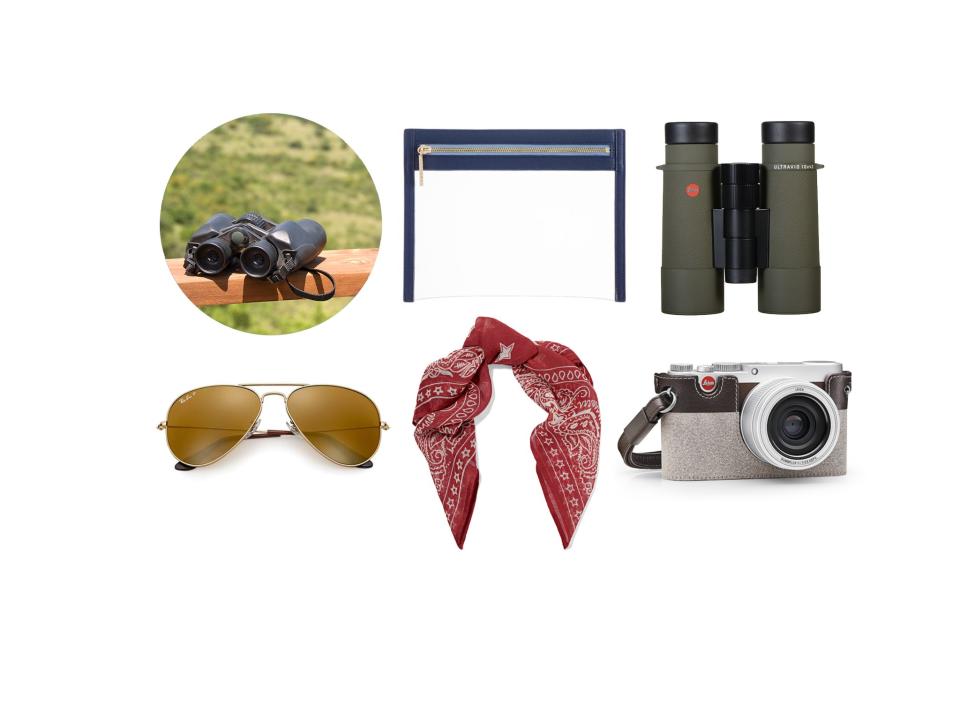
The Essential Gear
Most luxury safari lodges will provide guests with binoculars, but they’re the one thing you’ll absolutely want to have on game drives and walking safaris. You’ll also need a great quality pair of sunglasses with polarized lenses, plenty of extra memory sticks for your camera, and a bandana that you can dip in water and wrap around your neck if you get hot while out and about. An unexpected tip we got from a specialist? Bring bubble wrap to protect any new souvenirs you pick up (especially useful when you’re packing everything in a soft duffel!).
Ray-Ban Aviator Classic ($153, ray-ban.com); Truffle Clarity Clutch ($45, truffleco.com); Chan Luu scarf ($35, net-a-porter.com); Leica 10x42 Ultravid Binocular, Safari Edition ($1,799, bhphotovideo.com); Leica X Digital Camera (Typ 113) and Protector Country Case ($1,149 and $150, bhphotovideo.com).

Around Camp
You’ll want casual, cozy clothes to wear while you’re lounging around camp. Sneakers are a good go-to shoe (you don’t need serious hiking boots, but it’s good to bring something with a decent tread), and don’t forget a bathing suit—many lodges or tented camps have gorgeous pools.
Everlane The Cashmere Square Hoodie ($140, everlane.com); Burberry wool wrap ($950, net-a-porter.com); Ugg Abela slipper ($80, ugg.com); Solid and Striped + Staud Stella swimsuit ($170, net-a-porter.com); Everlane The Cashmere Sweatpant ($140, everlane.com).
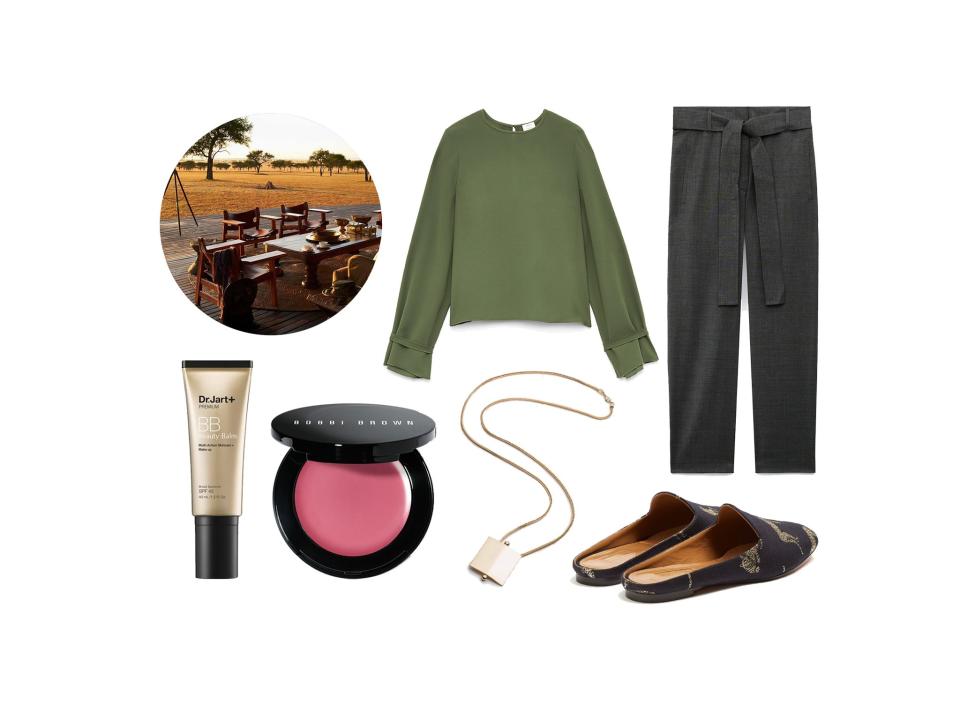
Safari-Chic Dinner
Some travelers like to have a more dressed-up option for dinner and cocktail hour back at camp—think flowy, breezy dresses, flats that can withstand a little dust, and a warm scarf to wrap yourself up in. In terms of accessories, leave any really bling-y jewelry at home and opt for a more pared down look.
Dr. Jart Premium Beauty Balm SPF 45 ($39, sephora.com); Bobbi Brown Pot Rouge for Lips & Cheeks ($30, bobbibrowncosmetics.com); Wilfred Elodie Blouse ($110, aritzia.com); Eddie Borgo Kite Pendant Necklace ($225, eddieborgo.com); Wilfred Jallade Pant ($145, aritzia.com); Aquazzura Brando flats ($500, matchesfashion.com).
Linda Friedman, CEO of Custom Safaris
Keep your boots in your carry-on. Avoid putting your hiking boots in your checked luggage, as they'll be difficult to replace if the case gets lost or stolen.
In fact, keep all essentials in your carry-on. Think of your carry-on as a mini survival kit, and stock it well, just in case. "Your hand-carry should contain medications and necessary items in the event your checked bag is lost or delayed," Friedman says. That means a few pieces of comfortable, nondescript clothing, waterproof hiking boots (already broken in), lightweight wool socks, a waterproof jacket, a hat, and garden gloves (to avoid stinging nettles). Friedman also suggests duct tape to wrap your ankles, a backpack for gorilla tracking, a camera (have a telephoto lens, and be aware flash photography is not allowed while gorilla tracking) and other electronics.
Wilderness Tours
Know what's not allowed. Kenya and Rwanda are polythene-free countries. "For environmental reasons, plastic bags are illegal and have been banned, the customary plastic duty-free bags included. For liquids in hand luggage, it is recommended to use transparent toiletry bags," the tour operators say.
Be prepared to hand-wash your underwear. "At certain camps and lodges, the staff will not wash underwear, due to prevailing local cultural traditions in the country. In these instances, environmentally friendly washing detergent can be supplied for you to wash your own items. At some camps and lodges, a mesh laundry bag is supplied so that you may place your underwear into this bag, which will then be machine washed with other laundry and returned in the same mesh laundry bag."
In addition to sunglasses, visas, tickets, passports, money, and malaria tablets, make sure you pack: a flashlight or head lamp and a Southern African bird guide (like Newman’s or Sasol.
Phoebe Weinberg, President of Greatways Travel, Inc.
Weinberg gave an extensive list of 20 packing essentials for Southern and Eastern Africa, including the aforementioned lightweight clothing, binoculars, warmer layers, and extra camera batteries. Her other tips:
Bring a bandana, and hats when it's cold. "A bandana, when warm and dipped in water, is very refreshing around your neck. When it's chilly, definitely bring a hat, warm scarf/pashmina, and gloves or mittens."
Have playing cards and books on hand. You're going to have some down time in between game drives and bush walks, so bring something to occupy yourself with. Need some inspiration? We've got a list of books to read before you go on safari, and you can check it out here.
Leave drones at home. Drones aren't allowed at any East African camps, so don't waste space packing one.
Plan space for souvenirs. We're all about souvenirs at Traveler, so make sure to pack a second duffle bag when you go on safari—that way, you'll have plenty of room to bring home memorabilia on the way back.
This article was originally published in 2012. It has been updated with new information.
